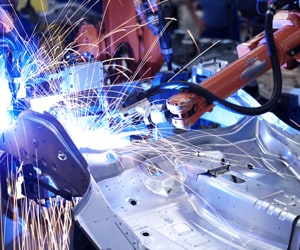
TE Perspectives
Unleashing a New Era of Smart Manufacturing
Authors: Anil Kumar Ramsesh Ph.D, Engineering Fellow, Industrial; and Ivan Ruiz Stubelj, Manager, Strategic Business Development, Automation Controls
Henry Ford’s introduction of the conveyor belt assembly line revolutionized efficiency so thoroughly that an automated sequential process is still the basis of many manufacturing architectures today. That model may finally be poised to change.
Robotic automation and the ability to leverage a wealth of data have brought speed and precision to the manufacturing process. As manufacturing has become more efficient, the range and variety of products factories are able to produce has also grown. Customer choice has come a long way from Ford’s initial offering of “any color, as long as it’s black.” Now, with the emergence of the industrial internet of things, manufacturers can augment their legacy systems with software that allows manufacturing components to operate independently of each other.
This capability promises an era of flexible, decentralized manufacturing architectures that can take advantage of efficiencies beyond Ford’s wildest dreams. Before this architectural shift can take place, however, manufacturers will need to settle on connectivity solutions that bring interoperability to the modular components that will enable this more flexible, decentralized process.

The Challenges of Decentralization
Introducing a new manufacturing architecture is complicated. Factories that aren’t operating aren’t profitable, so even paradigm-shifting changes must be achievable quickly and efficiently. Video analytics, machine learning and artificial intelligence make it possible to train and retrain existing machines to take on different tasks under different circumstances. Automating the transitions between those tasks requires sensors to measure circumstances and conditions on the factory floor or in the supply chain.
Virtualization makes it possible to test and refine new manufacturing configurations at relatively low cost. By testing these systems thoroughly before implementing them, manufacturers can reduce downtime and ensure that new processes will be reliable.
It also opens the door for decentralized architectures that move control from a central cabinet to the components themselves. In other words, making a factory’s components more flexible requires making them more intelligent. No matter how intelligent devices become, however, they must be able to communicate with one another to function efficiently as a system.
Insights on Smart Manufacturing Technologies
Embracing Modularity
Designing manufacturing systems with interchangeable, independent modules components that can be easily assembled, disassembled and upgraded will support rapid customization of production lines and seamless integration of new technologies. Enabling this interoperability will require a standardized method for delivery of both data and power wherever and whenever they are needed on the factory floor.
Manufacturers like TE Connectivity are playing an important role in the development of these modular designs. Our knowledge of connectivity solutions means we can guide our customers toward emerging components and designs that enable greater flexibility. Single pair ethernet (SPE) has emerged as a strong contender for the standardized communication protocol needed to support interoperability of modular manufacturing systems. Because SPE transmits both power and data over a single twisted pair of wires, it can help simplify connectivity questions and reduce the complexity associated with traditional cabling architectures. This approach could help make installation easier and foster a cleaner, more organized industrial environment. Both of these features are prerequisites for flexible architectures that could require rearranging the factory floor or repositioning devices.
Building more intelligence into connectors will also be a key part of this process. Because connections will need to change dynamically to support different workflows, they must be able to identify their connection status and communicate that information to other modules so it’s clear what components are available for repurposing.
Breaking Free of the Conveyor Belt
Ultimately, modularity will make it possible to reconfigure processes as needed without having to physically reconfigure the factory floor. Instead, automated guided vehicles will move products where they need to go, navigating the manufacturing cells in the most efficient sequence possible.
This level of flexibility opens the door to accommodating a wider variety of end products on a given set of equipment. As customer demand changes and products become more customizable, decentralized manufacturing systems could shift quickly to match changes in demand.
Systems that can support multiple parallel manufacturing sequences or have microstations execute different tasks offer opportunities to optimize production volume and variation as needed.
If demand spikes for a particular product variant, for example, the factory could reconfigure to produce a high volume of that single variant and then transition back to producing lower volumes of multiple variants when demand recedes.
That flexibility is not only good for efficient production. It could also help make factories more sustainable by allowing them to use existing machinery for a wider array of tasks—or repurpose it entirely to suit a new product’s workflow.
Before manufacturers can take this next step in architectures, however, they need the ability to convey data and power flexibly throughout a decentralized system. This degree of automation might require integration of wireless technology such as 5G to extend existing networks of decentralized manufacturing stations so that fleets of vehicles can interact with them. It could also require specialized power systems to maximize efficient operation and minimize downtime of the vehicles themselves. In addition, they will need sensors to detect and convey the context needed to integrate the vehicles’ decision making with the other devices on the factory floor.
Bridging the Gap to Radically New Architectures
Much of the technology needed to bring this more flexible future to life already exists in some form in a variety of industries. Electric vehicle technology in the automotive industry and fleet technology in the commercial transportation sector will offer valuable lessons for developing and managing fleets of automated vehicles on the factory floor.
Advancements in the energy sector will provide lessons about energy transmission and the electrical infrastructure that will power the elements of decentralized manufacturing architectures, even as manufacturers increasingly embrace renewable power sources that are making conventional power connectors obsolete. Sensors in the transportation industry and elsewhere will help provide the intelligence that equipment needs to automate tasks and make decisions, while data intelligence will help ensure predictive maintenance takes place on an optimal schedule to minimize downtime.
Not all manufacturers will be ready to leap into a decentralized factory floor at the same time. Different applications have different needs and requirements. At TE, we are helping our customers prepare for this future by upgrading their manufacturing infrastructure to accommodate greater flexibility wherever possible. Building intelligence into connectors and meeting evolving power requirements efficiently will prepare manufacturers to adopt the right solution when the time is right.
About the Authors

Anil Kumar Ramsesh Ph.D
Anil Kumar Ramsesh Ph.D is an Engineering Fellow with TE's Industrial business unit. Anil is a multidisciplinary problem solver with experience in applied research, technology development, and knowledge-based lean product development. His three decades of experience in research and product development enables him to understand the complex multidisciplinary product designs, customer needs, and provide solution. He is a passionate mentor and teacher and well-connected with universities, which enables him to support TE’s talent and technology needs. Anil is an alumnus of Indian Institute of Science with approximately 35 years of industry experience. Before joining TE Connectivity, Anil has worked for DOVER, Honeywell, and Indian Space Research Organization.

Ivan Ruiz Stubelj
Ivan Ruiz Stubelj serves as Manager of Strategic Business Development for Automation Controls, guiding application strategy and business development within TE’s Industrial business unit. Drawing on 19 years of diverse experience from the industrial automation, oilfield services, mining and metals, and pharmaceutical sectors, Ivan has honed his expertise across various roles in operations, supply chain, product development, and product management. Ivan holds a bachelor's in Industrial Engineering from Universidad Tecnológica Nacional of Buenos Aires, an EMBA from ESCP Business School, and an MSc in Computer Science from the University of Bath.
More Stories on Tech Innovation
 e
e
 e
e
 e
e


 e
e
 e
e

